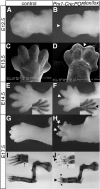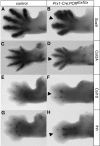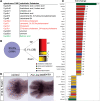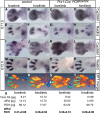Cholesterol metabolism: the main pathway acting downstream of cytochrome P450 oxidoreductase in skeletal development of the limb
- PMID: 19273610
- PMCID: PMC2682028
- DOI: 10.1128/MCB.01638-08
Cholesterol metabolism: the main pathway acting downstream of cytochrome P450 oxidoreductase in skeletal development of the limb
Abstract
Cytochrome P450 oxidoreductase (POR) is the obligate electron donor for all microsomal cytochrome P450 enzymes, which catalyze the metabolism of a wide spectrum of xenobiotic and endobiotic compounds. Point mutations in POR have been found recently in patients with Antley-Bixler-like syndrome, which includes limb skeletal defects. In order to study P450 function during limb and skeletal development, we deleted POR specifically in mouse limb bud mesenchyme. Forelimbs and hind limbs in conditional knockout (CKO) mice were short with thin skeletal elements and fused joints. POR deletion occurred earlier in forelimbs than in hind limbs, leading additionally to soft tissue syndactyly and loss of wrist elements and phalanges due to changes in growth, cell death, and skeletal segmentation. Transcriptional analysis of E12.5 mouse forelimb buds demonstrated the expression of P450s involved in retinoic acid, cholesterol, and arachidonic acid metabolism. Biochemical analysis of CKO limbs confirmed retinoic acid excess. In CKO limbs, expression of genes throughout the whole cholesterol biosynthetic pathway was upregulated, and cholesterol deficiency can explain most aspects of the phenotype. Thus, cellular POR-dependent cholesterol synthesis is essential during limb and skeletal development. Modulation of P450 activity could contribute to susceptibility of the embryo and developing organs to teratogenesis.
Figures









Similar articles
-
Conditional deletion of cytochrome p450 reductase in osteoprogenitor cells affects long bone and skull development in mice recapitulating antley-bixler syndrome: role of a redox enzyme in development.PLoS One. 2013 Sep 25;8(9):e75638. doi: 10.1371/journal.pone.0075638. eCollection 2013. PLoS One. 2013. PMID: 24086598 Free PMC article.
-
P450 oxidoreductase deficiency: a disorder of steroidogenesis with multiple clinical manifestations.Sci Signal. 2012 Oct 23;5(247):pt11. doi: 10.1126/scisignal.2003318. Sci Signal. 2012. PMID: 23092891 Review.
-
P450 oxidoreductase expressed in rat chondrocytes modulates chondrogenesis via cholesterol- and Indian Hedgehog-dependent mechanisms.Endocrinology. 2009 Jun;150(6):2732-9. doi: 10.1210/en.2009-0043. Epub 2009 Mar 5. Endocrinology. 2009. PMID: 19264869
-
Relationship between hepatic phenotype and changes in gene expression in cytochrome P450 reductase (POR) null mice.Biochem J. 2005 Jun 15;388(Pt 3):857-67. doi: 10.1042/BJ20042087. Biochem J. 2005. PMID: 15717863 Free PMC article.
-
Clinical and biochemical consequences of p450 oxidoreductase deficiency.Endocr Dev. 2011;20:63-79. doi: 10.1159/000321221. Epub 2010 Dec 16. Endocr Dev. 2011. PMID: 21164260 Review.
Cited by
-
Impaired hepatic drug and steroid metabolism in congenital adrenal hyperplasia due to P450 oxidoreductase deficiency.Eur J Endocrinol. 2010 Dec;163(6):919-24. doi: 10.1530/EJE-10-0764. Epub 2010 Sep 15. Eur J Endocrinol. 2010. PMID: 20844025 Free PMC article.
-
Craniosynostosis and multiple skeletal anomalies in humans and zebrafish result from a defect in the localized degradation of retinoic acid.Am J Hum Genet. 2011 Nov 11;89(5):595-606. doi: 10.1016/j.ajhg.2011.09.015. Epub 2011 Oct 20. Am J Hum Genet. 2011. PMID: 22019272 Free PMC article.
-
Effects of Diminished NADPH:cytochrome P450 Reductase in Human Hepatocytes on Lipid and Bile Acid Homeostasis.Front Pharmacol. 2021 Nov 15;12:769703. doi: 10.3389/fphar.2021.769703. eCollection 2021. Front Pharmacol. 2021. PMID: 34867397 Free PMC article.
-
The molecular biology, biochemistry, and physiology of human steroidogenesis and its disorders.Endocr Rev. 2011 Feb;32(1):81-151. doi: 10.1210/er.2010-0013. Epub 2010 Nov 4. Endocr Rev. 2011. PMID: 21051590 Free PMC article. Review.
-
Regulation of gap junction function and Connexin 43 expression by cytochrome P450 oxidoreductase (CYPOR).Biochem Biophys Res Commun. 2011 Aug 5;411(3):490-5. doi: 10.1016/j.bbrc.2011.06.132. Epub 2011 Jun 25. Biochem Biophys Res Commun. 2011. PMID: 21726529 Free PMC article.
References
-
- Bijlsma, M. F., K. S. Borensztajn, H. Roelink, M. P. Peppelenbosch, and C. A. Spek. 2007. Sonic hedgehog induces transcription-independent cytoskeletal rearrangement and migration regulated by arachidonate metabolites. Cell Signal. 192596-2604. - PubMed
-
- Black, S. D., and M. J. Coon. 1987. P-450 cytochromes: structure and function. Adv. Enzymol. Relat. Areas Mol. Biol. 6035-87. - PubMed
-
- Blomhoff, R., and H. K. Blomhoff. 2006. Overview of retinoid metabolism and function. J. Neurobiol. 66606-630. - PubMed
-
- Bogatcheva, N. V., M. G. Sergeeva, S. M. Dudek, and A. D. Verin. 2005. Arachidonic acid cascade in endothelial pathobiology. Microvasc. Res. 69107-127. - PubMed
Publication types
MeSH terms
Substances
Grants and funding
LinkOut - more resources
Full Text Sources
Medical
Molecular Biology Databases
